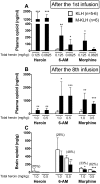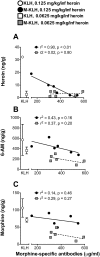Pharmacokinetic correlates of the effects of a heroin vaccine on heroin self-administration in rats
- PMID: 25536404
- PMCID: PMC4275252
- DOI: 10.1371/journal.pone.0115696
Pharmacokinetic correlates of the effects of a heroin vaccine on heroin self-administration in rats
Abstract
The purpose of this study was to evaluate the effects of a morphine-conjugate vaccine (M-KLH) on the acquisition, maintenance, and reinstatement of heroin self-administration (HSA) in rats, and on heroin and metabolite distribution during heroin administration that approximated the self-administered dosing rate. Vaccination with M-KLH blocked heroin-primed reinstatement of heroin responding. Vaccination also decreased HSA at low heroin unit doses but produced a compensatory increase in heroin self-administration at high unit doses. Vaccination shifted the heroin dose-response curve to the right, indicating reduced heroin potency, and behavioral economic demand curve analysis further confirmed this effect. In a separate experiment heroin was administered at rates simulating heroin exposure during HSA. Heroin and its active metabolites, 6-acetylmorphine (6-AM) and morphine, were retained in plasma and metabolite concentrations were reduced in brain in vaccinated rats compared to controls. Reductions in 6-AM concentrations in brain after vaccination were consistent with the changes in HSA rates accompanying vaccination. These data provide evidence that 6-AM is the principal mediator of heroin reinforcement, and the principal target of the M-KLH vaccine, in this model. While heroin vaccines may have potential as therapies for heroin addiction, high antibody to drug ratios appear to be important for obtaining maximal efficacy.
Conflict of interest statement
Figures





Similar articles
-
Selective effects of a morphine conjugate vaccine on heroin and metabolite distribution and heroin-induced behaviors in rats.J Pharmacol Exp Ther. 2013 Feb;344(2):397-406. doi: 10.1124/jpet.112.201194. Epub 2012 Dec 7. J Pharmacol Exp Ther. 2013. PMID: 23220743 Free PMC article.
-
Dynamic vaccine blocks relapse to compulsive intake of heroin.Proc Natl Acad Sci U S A. 2013 May 28;110(22):9036-41. doi: 10.1073/pnas.1219159110. Epub 2013 May 6. Proc Natl Acad Sci U S A. 2013. PMID: 23650354 Free PMC article.
-
A morphine/heroin vaccine with new hapten design attenuates behavioral effects in rats.J Neurochem. 2011 Dec;119(6):1271-81. doi: 10.1111/j.1471-4159.2011.07502.x. Epub 2011 Oct 28. J Neurochem. 2011. PMID: 21951213
-
The therapeutic use of heroin: a review of the pharmacological literature.Can J Physiol Pharmacol. 1986 Jan;64(1):1-6. doi: 10.1139/y86-001. Can J Physiol Pharmacol. 1986. PMID: 2420426 Review.
-
Vaccines against morphine/heroin and its use as effective medication for preventing relapse to opiate addictive behaviors.Hum Vaccin. 2009 Apr;5(4):214-29. doi: 10.4161/hv.5.4.7556. Epub 2009 Apr 8. Hum Vaccin. 2009. PMID: 19242094 Review.
Cited by
-
Calix[n]arene-based immunogens: A new non-proteic strategy for anti-cocaine vaccine.J Adv Res. 2021 Sep 13;38:285-298. doi: 10.1016/j.jare.2021.09.003. eCollection 2022 May. J Adv Res. 2021. PMID: 35572397 Free PMC article.
-
A bacteriophage virus-like particle vaccine against oxycodone elicits high-titer and long-lasting antibodies that sequester drug in the blood.Vaccine. 2024 Jan 25;42(3):471-480. doi: 10.1016/j.vaccine.2023.12.077. Epub 2023 Dec 29. Vaccine. 2024. PMID: 38160131 Free PMC article.
-
The development of opioid vaccines as a novel strategy for the treatment of opioid use disorder and overdose prevention.Int J Neuropsychopharmacol. 2025 Feb 4;28(2):pyaf005. doi: 10.1093/ijnp/pyaf005. Int J Neuropsychopharmacol. 2025. PMID: 39831679 Free PMC article. Review.
-
Pharmacological mechanisms underlying the efficacy of antibodies generated by a vaccine to treat oxycodone use disorder.Neuropharmacology. 2021 Sep 1;195:108653. doi: 10.1016/j.neuropharm.2021.108653. Epub 2021 Jun 11. Neuropharmacology. 2021. PMID: 34126123 Free PMC article.
-
Development of vaccines to treat opioid use disorders and reduce incidence of overdose.Neuropharmacology. 2019 Nov 1;158:107662. doi: 10.1016/j.neuropharm.2019.06.001. Epub 2019 Jun 4. Neuropharmacology. 2019. PMID: 31173759 Free PMC article. Review.
References
-
- UNODC (2012) World Drug Report 2012.
-
- NSDUH (2012) Results from 2012 National Survey on Drug Use and Health: Summary of National Findings.
-
- Anton B, Leff P (2006) A novel bivalent morphine/heroin vaccine that prevents relapse to heroin addiction in rodents. Vaccine 24:3232–3240. - PubMed
Publication types
MeSH terms
Substances
Grants and funding
LinkOut - more resources
Full Text Sources
Other Literature Sources
Medical

